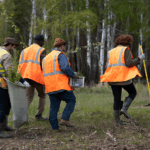

So, you just became the recovery lead.
Maybe it was official. Maybe it wasn’t. Maybe someone just looked around the room and said, “Hey, you’re good with people—can you run point on this?”
Regardless of how it happened, you’re it now.
And you’re probably wondering: What the hell do I do first?
That question is more common than most people realize. There is no national playbook. No universal checklist. No magic binder labeled “In Case of Disaster, Start Here.”
And yet… the pressure’s already on. Everyone wants answers. Funding is in motion. Decisions are piling up. And you’re trying to build the plane while it’s already halfway down the runway.
Here’s the good news: You’re not alone.
Here’s the better news: You don’t have to get it perfect—you just have to get it moving.
Step One: Stop Looking for the Perfect Plan
If you’re waiting to understand everything before making a move, you’re going to stall your own recovery.
You do not need:
A fully built strategy
A perfect understanding of every funding stream
Or a master plan before acting
What you need is structure. Just enough of it to start sorting the chaos into buckets.
You’re not building a five-year vision right now—you’re building the scaffolding that will let you and your team survive the next 30, 60, and 90 days without burning out or duplicating work.
Step Two: Build the Table (Even If It’s Just a Folding One)
Recovery leadership isn’t about heroic decisions—it’s about creating a system that others can plug into. That starts with:
A regular meeting schedule
Clear roles (even if there are only two of you)
A way to track what’s happening, what’s needed, and who’s doing what
Somewhere to write things down and revisit them later
It doesn’t have to be fancy. It just has to be real.
You’re not running a response operation anymore. You’re building something longer and messier. And the sooner you start creating routines, tracking decisions, and pulling people into a shared rhythm, the faster things stabilize.
Step Three: Map What You Actually Know (Not What You Wish You Knew)
Right now, your inbox is probably full of half-baked assessments, rumor-fueled assumptions, and five competing funding timelines. That’s normal.
Don’t wait for clarity—create it.
Start mapping what you do know:
What systems were impacted most (housing, infrastructure, economy, etc.)?
What funding has been announced, and what’s still pending?
Who’s already doing good work that you can align with instead of duplicating?
Build a simple, messy, living document. It’s not for public release—it’s your internal compass.
Step Four: Identify What Needs a Home
One of the biggest early mistakes recovery leads make is assuming everything already has an owner.
Spoiler: It doesn’t.
Recovery is full of orphaned tasks.
There are things people assume someone else is handling—but no one is.
Is anyone coordinating debris and permitting timelines?
Has anyone actually scoped the staffing you’ll need in year two?
Who’s tracking unmet needs that won’t be covered by FEMA or HUD?
Part of your job now is to spot those floating pieces and start giving them a home—either in your team or somewhere else.
This is where that “structure before strategy” mindset becomes critical. If you build a strong recovery skeleton, you can keep layering in new roles, programs, and partners without collapsing.
Step Five: Find Allies, Not Just Staff
You don’t need 30 FTEs right now.
You need 3 people who understand the mission, can navigate ambiguity, and are willing to help you figure it out in real time.
That might include:
A trusted emergency manager who’s good with logistics
A local planner who knows the zoning and permitting landscape
A nonprofit partner with deep ties to community needs
Start small. Meet weekly. Make decisions. Write things down. Adjust as you go.
You’re not just filling a team—you’re building a core operating rhythm.
Step Six: Don’t Mistake Movement for Progress
Early recovery is full of motion. Site visits, press releases, kickoff meetings, assessments. It all feels productive. But don’t confuse visibility with traction.
What you need to track in these first weeks:
What problems are being solved?
What systems are being stood up?
What needs are going unnoticed?
If everything is urgent, nothing is prioritized. Your job is to start organizing the chaos into stacks—urgent tasks, emerging systems, long-term needs.
You’ll get it wrong sometimes. That’s okay. Adjust. Keep going.
Step Seven: Say This Out Loud, Weekly
“Recovery is a long-term effort. We are building the systems now that will carry us over the next 3 to 5 years. This won’t be perfect, but we’re committed to steady progress and shared visibility.”
Say it to your team. Say it to your boss. Say it to funders, residents, and partners.
Because if you don’t set expectations early, they will set themselves—and you’ll spend the next year cleaning up after them.
What You’re Actually Doing Right Now
Let’s cut through the noise.
Your job in the first 30–90 days is to:
Stand up the structure
Identify gaps no one else sees
Start making small, smart decisions
Build trust and traction—not perfection
You’re not here to be the savior.
You’re here to set the recovery in motion.
Final Thought: You’re Closer Than You Think
Most recovery leads feel behind. Like they’re supposed to already know everything. Like everyone else has it more together.
They don’t.
The truth is, the people who succeed in this role aren’t the ones who start with all the answers—they’re the ones who build the right systems to find them, adapt them, and keep going.
You’ve got this. And we’ve got your back.
Explore our full training catalog for lessons and tools that help you plan smarter, coordinate across layers, and lead recovery on timelines that reflect the real world—not a spreadsheet.



